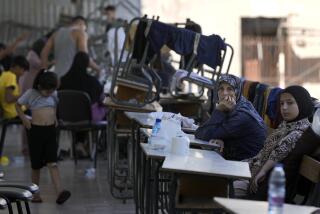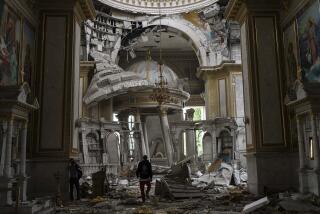In Syria, Old Damascus now a quiet, shrunken core
DAMASCUS, Syria — Somewhere between the Christian and historical Jewish quarters of Old Damascus, labyrinthine alleys lead to a nondescript cobblestone tunnel that opens onto an Ottoman-era home, one of this ancient capital’s many boutique hotels.
Inside, across a courtyard and along the basalt stone wall, several young artists and musicians sit beneath a tangerine tree chatting and smoking a hookah, or water pipe.
One strums a setar, a three-string lute indigenous to the region. The melody surfs across the sound of gurgling water from a nearby fountain.
Such tranquillity, however, is fleeting: The clamor of fighter jets and thump of shelling regularly pierces the Old City’s venerable stone walls.
“Something big is about to happen here,” said Osama Nasser, 24, a painter, seemingly oblivious to the booms. But he was not talking about the war; he was referring to Syria’s shifting art scene. “I see a lot of new ideas and expressions. It’s going to be big.”
Despite Nasser’s generous aesthetic vision, Old Damascus — as recently as 2010 a vibrant destination featured in international travel magazines — has all but shriveled into a panicky garrison town. The district’s once-dynamic art milieu has contracted dramatically, and its trendy hotels have hit hard times as people displaced by war have supplanted tourists as the major clientele.
Major artists who were fixtures in the Old City have left, along with the exhibits that once graced galleries and storefronts. Hip hostelries that hosted the likes of Angelina Jolie and Brad Pitt, who visited in 2009, now go empty for days. Long gone are the tourists who used to arrive in hordes, mesmerized by the aroma of spices and the sight of exquisite gewgaws.
Now armed security men, many not in uniform, swarm the winding streets of Old Damascus, keeping a close eye on comings and goings. These days, for a fraction of pre-conflict prices, the hotel rooms shelter some of the estimated 2 million Syrians who have been forced from their homes by violence.
At the hotel where Nasser and his friends gather, each room houses a displaced person or family. One guest, his face thin and haggard, sits in a dark corner of the courtyard, taking long, pensive drags on his cigarette as he listens to the setar player.
Nasser and his friends are among those who had to flee their homes. They now depend on the kindness of family and friends in the capital to find a place to sleep. The violence remains largely confined to the suburbs, though intense fighting in the city’s outskirts during a rebel offensive this month was heard throughout the city.
On Saturday, another power outage plunged Damascus and southern Syria into darkness, the Associated Press reported. The government has blamed previous blackouts on rebel attacks and sabotage.
Last month, government forces clashed with rebels near the Old City, only blocks from the Roman-era Bab Sharqi, also known as the Gate of the Sun. In October, a car bomb killed 10 in the district of Bab Touma, or St. Thomas’ Gate, a Christian landmark.
Many Damascenes fear what the rebels vow will be a decisive battle for the capital, where frequent checkpoints provide internal security, soldiers guard strategic corners and armored vehicles rumble down main thoroughfares.
Yet the war has so far largely spared Old Damascus the damage that has devastated Aleppo, Syria’s commercial capital before the conflict, and its vast Souk Madina, a sprawling market dating to medieval times. Conservationists worry that Aleppo’s fate could befall Damascus, a repository of global history.
It was here in the ancient quarter that St. Paul is said to have walked through the Via Recta. It was here also that pre-Christian residents erected a temple for Hadad, the pagan god of rain. Later, a Christian basilica dedicated to St. John was built on the temple site, and later still the Umayyad Mosque, a landmark in the Muslim world.
During an economic boom that began in 2005, when the Syrian government opened up the long-state-dominated economy, entrepreneurs began to restore some of the hundreds of Ottoman-era homes and caravan serai, or former travelers hostels, turning the structures into exquisite boutique hotels. The evocative guesthouses feature luxurious carpets, ceilings inlaid with mother of pearl, solid volcanic stone walls and mosaic tiles, sometimes entirely from the original period.
In 2010, demand was so high that it was impossible to find a room at one of the inns, at $250 a night, without reservations made weeks or even months in advance.
Hotels still vying to attract the remaining trickle of visitors must overcome staff shortages (many former employees live in conflict-scarred suburbs) and electricity outages, as power lines and transformers have been damaged in rebel attacks and government bombardment. Much of the city receives power for just a few hours a day. Businesses and individuals have turned to private generators, though fuel is in short supply and expensive.
“Now when we get a reservation, we can’t take it because we don’t have heating,” said one hotel’s manager, standing by a wall filled with pictures of him with international celebrities.
“We’ve been waiting for fuel delivery so we can power up our generator,” said the manager, who, like others interviewed, declined to give his name for security reasons, reflecting the pervasive fear here. “Once it arrives, we’ll be able to take reservations.”
In the hotel courtyard where Nasser gathers with his friends, walls showcase their oil paintings. The artists recently converted the place into a makeshift gallery. For a modest fee, they offer private drawing and music lessons — and a respite from the mayhem outside.
“I remind myself that Old Damascus has survived thousands of years, with wars throughout history,” said a young architect, pointing to his college thesis, a three-dimensional model of a completely restored Old City, on display in the courtyard. “I have faith it will survive this war too.”
As for Nasser, whose work has been described by one critic as something like a “leaner, meaner Edvard Munch” — after the Norwegian painter known for harrowing portraits, including “The Scream” — the conflict, with all its tragedy, remains a source of inspiration.
“The violence changes the energy within me,” Nasser explained. “I have no control. It just moves my brush.”
Elass is a special correspondent.
More to Read
Sign up for Essential California
The most important California stories and recommendations in your inbox every morning.
You may occasionally receive promotional content from the Los Angeles Times.










